The Dames of Tring Park
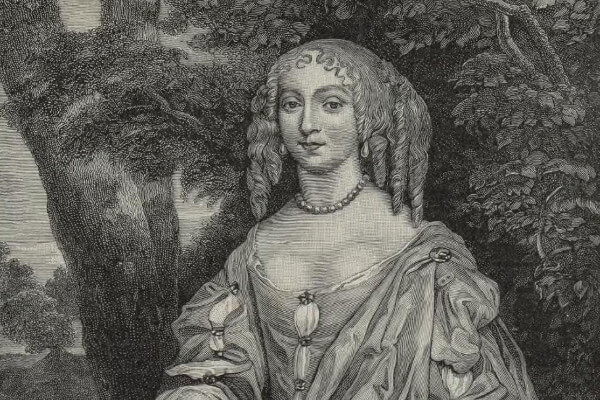
Tring park is a favourite place for a walk, but has a fascinating history – including being the home of two famous actresses…
Have you ever walked past the white folly in Tring Park and wondered why it was there? The white ‘porch’ with pillars is actually what remains of a summerhouse.
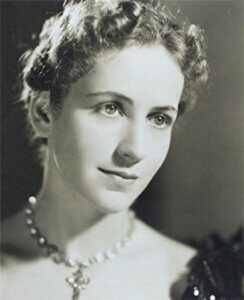 And it had a famous resident during World War Two – the actress Dame Peggy Ashcroft. Born Edith Margaret Emily Ashcroft in 1907, her theatrical career lasted more than 60 years, appearing at the Old Vic, with the Shakespeare Memorial Theatre, later the Royal Shakespeare Company and the National Theatre. She later won two BAFTAs and an Oscar.
And it had a famous resident during World War Two – the actress Dame Peggy Ashcroft. Born Edith Margaret Emily Ashcroft in 1907, her theatrical career lasted more than 60 years, appearing at the Old Vic, with the Shakespeare Memorial Theatre, later the Royal Shakespeare Company and the National Theatre. She later won two BAFTAs and an Oscar.
She was made a Dame in the 1950s, and after she died in 1991, a memorial plaque was placed in Poets’ Corner in Westminster Abbey,
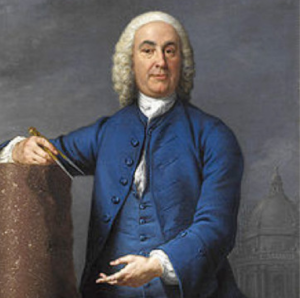 The summerhouse that became her home during the War was probably designed by James Gibbs, who also designed the Obelisk, which sits along a path away to the folly.
The summerhouse that became her home during the War was probably designed by James Gibbs, who also designed the Obelisk, which sits along a path away to the folly.
Built in neoclassical Greek style, the summerhouse was built of red brick and painted plaster. The front facade, which is now all that remains, has the look of an ancient temple, as the four columns support a decorative portico.
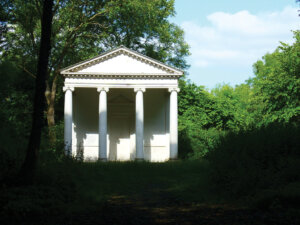
During the late 19th century, it was home to a gamekeeper and his son, and during World War Two, Dame Peggy lived there while Jeremy Hutchinson, her husband, who she married in 1940, was away at sea. It was his family connection that would have led them to Tring, as his sister was married to the third Lord Rothschild, Victor. The couple lived in the nearby Ranger’s Cottage.
John Gielgud wrote to his mother in June 1941 that he ‘Had a cheerful letter from Peggy [Ashcroft]. She is at Tring but goes to Oxford to have her baby in two weeks time, so I hope to see her there, safely delivered. Her husband [Jeremy Hutchinson] was on the Kelly at Crete, one of the twelve officers saved, thank God. She must have had some terribly anxious days but has now heard he is at Alexandria.’ She did indeed have her baby, a daughter called Eliza.
The main part of the summerhouse was later demolished to make way for the Wigginton Road.
But of course, Dame Peggy is not the only famous actress to be linked to the town and its park. In the 17th century, Tring was owned by Charles II’s wife Catherine of Braganza. When Queen Catherine died, the King gave the Manor of Great Tring to his Groom of the Bedchamber and Clerk of the Treasury, Henry Guy. One of Henry’s jobs was to make regular payments to the royal mistresses, so it is likely that he was charged with looking after Charles’ beloved mistress Nell Gwyn.
The Obelisk was either built in honour of Nell, who lived for some time in Tring, or to commemorate a visit to Tring by her and Charles II. For those who believe Nell lived here, her home was said to be ‘Dunsley House’, situated on the edge of Tring Park near the Memorial Gardens.
Legend has it that Nell stayed in Tring either while she was pregnant by the King, or to protect her when typhus was rife in London. When the first Lord Rothschild acquired the Tring Park Estate, he employed the best researchers to verify the story, to add to the historic interest of his new property, but they were unable to find hard proof of Nell’s connection.
The Obelisk, which was erected 100 years after her death, is believed to be the only monument to a royal mistress in the country.
As a girl, Nell and her sister Rose worked as ‘orange-girls’ at a theatre – their job was to sell fruit to the audience. It was there that Nell became the mistress of the theatre’s leading man, Charles Hart, and a year later, in 1665, she became one of England’s very first public actresses.
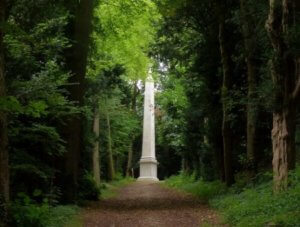 Many Tring children will have grown up knowing that there’s a magic way to make an orange appear at Nell’s Monument. You should run around the Obelisk while holding your breath if you want an orange to fall from its top, or more specifically, visit at midnight on Midsummer’s eve, run around the monument three times backwards and Nell’s ghost will appear and throw oranges at you… We wonder how many children over the years have tried it – and how many have been successful!
Many Tring children will have grown up knowing that there’s a magic way to make an orange appear at Nell’s Monument. You should run around the Obelisk while holding your breath if you want an orange to fall from its top, or more specifically, visit at midnight on Midsummer’s eve, run around the monument three times backwards and Nell’s ghost will appear and throw oranges at you… We wonder how many children over the years have tried it – and how many have been successful!

